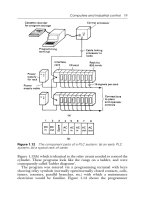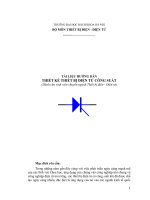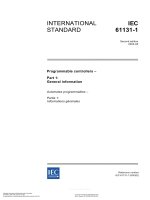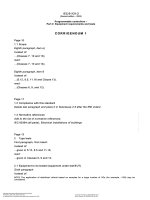Programmable Controllers an engineer guide P1
Bạn đang xem bản rút gọn của tài liệu. Xem và tải ngay bản đầy đủ của tài liệu tại đây (1.1 MB, 30 trang )
Programmable Controllers
075065757X-ch000-prelims.fm Page i Saturday, June 28, 2003 4:46 PM
In memory of Arthur Parr, 1913–1992.
Man is still the most extraordinary computer of all.
John F. Kennedy
21 May 1963
075065757X-ch000-prelims.fm Page ii Saturday, June 28, 2003 4:46 PM
Programmable Controllers
An engineer’s guide
Third edition
E.A. Parr, MSc, CEng, MIEE, MInstMC
AMSTERDAM BOSTON HEIDELBERG LONDON NEW YORK OXFORD
PARIS SAN DIEGO SAN FRANCISCO SINGAPORE SYDNEY TOKYO
Newnes
075065757X-ch000-prelims.fm Page iii Saturday, June 28, 2003 4:46 PM
Newnes
An imprint of Elsevier
Linacre House, Jordan Hill, Oxford OX2 8DP
200 Wheeler Road, Burlington, MA 01803
A division of Reed Educational and Professional Publishing Ltd
A member of the Reed Elsevier plc group
First published 1993
Second edition 1999
Third edition 2003
Copyright © E.A. Parr 1993, 1999, 2003. All rights reserved.
The right of E.A. Parr to be identified as the author of this work
has been asserted in accordance with the Copyright, Designs and
Patents Act 1988
No part of this publication
may be reproduced in any material form (including
photocopying or storing in any medium by electronic
means and whether or not transiently or incidentally
to some other use of this publication) without the
written permission of the copyright holder except
in accordance with the provisions of the Copyright,
Designs and Patents Act 1988 or under the terms of a
licence issued by the Copyright Licensing Agency Ltd,
90 Tottenham Court Road, London, England W1T 4LP.
Applications for the copyright holder’s written permission
to reproduce any part of this publication should be addressed
to the publishers
British Library Cataloguing in Publication Data
A catalogue record for this book is available
from the British Library
ISBN 0 7506 5757 X
Typeset by Integra Software Services Pvt. Ltd, Pondicherry, India
www.integra-india.com
Printed and bound in Great Britain
For information on all Newnes publications visit our website at:
newnespress.com
075065757X-ch000-prelims.fm Page iv Saturday, June 28, 2003 4:46 PM
Contents
Preface xi
1 Computers and industrial control
1
1.1 Introduction 1
1.2 Types of control strategies 1
1.2.1 Monitoring subsystems 2
1.2.2 Sequencing subsystems 2
1.2.3 Closed loop control subsystems 4
1.2.4 Control devices 5
1.3 Enter the computer 6
1.3.1 Computer architectures 7
1.3.2 Machine code and assembly language programming 11
1.3.3 High level languages 11
1.3.4 Application programs 14
1.3.5 Requirements for industrial control 14
1.3.6 The programmable controller 18
1.4 Input/output connections 21
1.4.1 Input cards 21
1.4.2 Output connections 22
1.4.3 Input/output identification 28
1.5 Remote I/O 29
1.6 The advantages of PLC control 31
075065757X-ch000-prelims.fm Page v Saturday, June 28, 2003 4:46 PM
vi Contents
2 Programming techniques 33
2.1 Introduction 33
2.2 The program scan 36
2.3 Identification of input/output and bit addresses 40
2.3.1 Racks, cards and signals 40
2.3.2 Allen Bradley PLC-5 41
2.3.3 Siemens SIMATIC S5 42
2.3.4 CEGELEC GEM-80 42
2.3.5 ABB Master 45
2.3.6 Mitsubishi F2 47
2.3.7 Internal bit storage 48
2.4 Programming methods 48
2.4.1 Introduction 48
2.4.2 Ladder diagrams 49
2.4.3 Logic symbols 52
2.4.4 Statement list 55
2.5 Bit storage 58
2.6 Timers 63
2.7 Counters 67
2.8 Numerical applications 72
2.8.1 Numeric representations 72
2.8.2 Data movement 75
2.8.3 Data comparison 77
2.8.4 Arithmetical operations 78
2.9 Combinational and event-driven logic 81
2.9.1 Combinational logic 81
2.9.2 Event-driven logic 86
2.10 Micro PLCs 95
2.11 IEC 1131-3, towards a common standard 99
2.12 Programming software 105
2.13 Programming software tools 109
3 Programming style
115
3.1 Introduction 115
3.2 Software engineering 116
3.3 Top-down design 118
075065757X-ch000-prelims.fm Page vi Saturday, June 28, 2003 4:46 PM
Contents vii
3.4 Program structure in various PLCs 119
3.5 Housekeeping and good software practice 128
3.6 Speeding up the PLC scan time 135
4 Analog signals, closed loop control
and intelligent modules 140
4.1 Introduction 140
4.2 Common analog signals 140
4.2.1 Temperature 140
4.2.2 Pressure 142
4.2.3 Flow 144
4.2.4 Speed 146
4.2.5 Weighing systems 146
4.2.6 Level 147
4.2.7 Position 148
4.2.8 Output signals 149
4.3 Signals and standards 149
4.4 Analog interfacing 151
4.4.1 Resolution 151
4.4.2 Multiplexed inputs 152
4.4.3 Conversion times 153
4.4.4 Channel selection and conversion to engineering units 156
4.4.5 Analog input cards 158
4.4.6 Filtering 160
4.5 Analog output signals 160
4.6 Analog-related program functions 163
4.7 Closed loop control 164
4.7.1 Introduction to control theory 164
4.7.2 Stability and loop tuning 167
4.7.3 Closed loop control and PLCs 168
4.8 Specialist control processors 172
4.9 Bar codes 173
4.10 High-speed counters 178
4.11 Intelligent modules 178
4.12 Installation notes 179
075065757X-ch000-prelims.fm Page vii Saturday, June 28, 2003 4:46 PM
viii Contents
5 Distributed systems 182
5.1 Parallel and serial communications 182
5.2 Serial standards 185
5.2.1 Introduction 185
5.2.2 Synchronization 185
5.2.3 Character codes 186
5.2.4 Transmission rates 186
5.2.5 Modulation of digital signals 189
5.2.6 Standards and protocols 191
5.2.7 Error control 196
5.2.8 Point to point communication 202
5.3 Area networks 205
5.3.1 Introduction 205
5.3.2 Transmission lines 205
5.3.3 Network topologies 207
5.3.4 Network sharing 209
5.3.5 A communication hierarchy 210
5.4 The ISO/OSI model 212
5.5 Proprietary systems 214
5.5.1 Introduction 214
5.5.2 Allen Bradley Data Highway 215
5.5.3 Gem-80 Starnet, ESP and CORONET 217
5.5.4 Siemens SINEC 218
5.5.5 Ethernet 218
5.5.6 Towards standardization 219
5.5.7 Profibus 223
5.6 Safety and practical considerations 224
5.7 Fibre optics 227
6 The man–machine interface 232
6.1 Introduction 232
6.2 Simple digital control and indicators 234
6.3 Numerical outputs and inputs 236
6.3.1 Numerical outputs 236
6.3.2 Multiplexed outputs 237
6.3.3 Leading zero suppression 240
6.3.4 Numerical inputs 240
6.4 Alarm annunciation 242
075065757X-ch000-prelims.fm Page viii Thursday, July 3, 2003 3:59 PM
Contents ix
6.5 Analog indication 247
6.6 Computer graphics 250
6.6.1 Introduction 250
6.6.2 The Allen Bradley Panelview 254
6.6.3 Pixel graphics; the CEGELEC Imagem 256
6.6.4 The Siemens Simatic HMI family 265
6.6.5 Practical considerations 267
6.6.6 Data entry 270
6.7 Message displays 271
6.8 SCADA packages 271
7 Industrial control with conventional computers 276
7.1 Introduction 276
7.2 Bus-based machines 277
7.2.1 Introduction 277
7.2.2 IEEE-488 parallel interface bus 278
7.2.3 Backplane bus systems 281
7.2.4 IBM PC clones 282
7.3 Programming for real time control 285
7.4 Soft PLCs 292
8 Practical aspects 293
8.1 Introduction 293
8.2 Safety 293
8.2.1 Introduction 293
8.2.2 Risk assessment 294
8.2.3 PLCs, computers and safety 296
8.2.4 Emergency stops 308
8.2.5 Guarding 312
8.2.6 Safety legislation 314
8.2.7 IEC 61508 315
8.3 Design criteria 320
8.4 Constructional notes 322
8.4.1 Power supplies 322
8.4.2 Equipment protection 325
8.5 Maintenance and fault finding 331
8.5.1 Introduction 331
8.5.2 Statistical representation of reliability 332
075065757X-ch000-prelims.fm Page ix Saturday, June 28, 2003 4:46 PM
x Contents
8.5.3 Maintenance philosophies 335
8.5.4 Designing for faults 337
8.5.5 Documentation 339
8.5.6 Training 344
8.5.7 Fault-finding aids, EDDI and FIMs 348
8.6 Electromagnetic compatibility (EMC)
and CE marking 354
8.7 Other programmable devices 359
9 Sample ladder logic 362
9.1 Introduction 362
9.2 One Shot 364
9.3 Toggle action 365
9.4 Alarm annunciator 368
9.5 First order filter 370
9.6 Level control 373
9.7 Linearization 380
9.8 Flow totalization 385
9.9 Scaling 391
9.10 Gray code conversion 394
9.11 BCD to Binary conversion 398
9.12 Binary to BCD conversion 400
9.13 A hydraulic system 403
Appendix Number systems 416
Index 421
075065757X-ch000-prelims.fm Page x Saturday, June 28, 2003 4:46 PM
Preface
All industrial processes need some form of control system if they are to
run safely and economically. In recent years a specialist control computer,
called a programmable controller, has evolved and revolutionized control
engineering by combining computing power and immense flexibility at
a reasonable price.
This book is concerned with the application and use of programmable
controllers. It is not an instructional book in programming, and is certainly
not a comparative guide to the various makes of machine on the market.
To some extent, choosing a programmable controller is rather like
choosing a word processor. You ask people for their views, try a few
simple examples in a shop, and buy the cheapest that you think meets
your requirements. Only after several months do you really know the
system. From then on, all other word processors seem awkward.
Programmable controllers are similar. Unless there are good reasons
for a particular choice (ready experience in the engineering or maintenance
staff, equipment being supplied by an outside contractor and similar
considerations), there are good and bad points with all (the really bad
machines left the market years ago).
At the Sheerness Steel Company where I work, the plant control is
based on about sixty programmable controllers consisting of Allen
Bradley PLC 2s and 5s, GEC (now CEGELEC) GEM-80s, ASEA (now
ABB) Masters and Siemens SIMATIC S5s, with small machines primar-
ily from Mitsubishi. These controllers are somewhat like the trees at
Galleons Lap in Winnie the Pooh; there never seems to be the same
number on two successive days, even if you tie a piece of string around
each one!
As with most plants, the background to this distribution of controllers
is largely historical chance (the original Mitsubishi came on a small
turn-key plant from an outside contractor, for example), but the ready
access to these machines is the reason for their prominence in this book.
075065757X-ch000-prelims.fm Page xi Saturday, June 28, 2003 4:46 PM
xii Preface
Even within this range of PLC families, the coverage in this book is
not complete. The PLCs have been chosen to cover the application points
I wish to make, not as a complete survey of a manufacturer’s range.
In ‘previous lives’ I have worked with PLCs from AEG, GE, Landys
and Gyr, Modicon, Telemecanique, Texas Instruments and many other
companies. To these manufacturers I offer my sincere apologies for not
giving them more coverage, but to do so would have made a tedious book
and masked the application points I have tried to make. I could happily
use any of these machines, and there is not a major difference in style or
philosophy between them (the manufacturers would no doubt disagree!).
The guideline is therefore choose a machine that suits you, and do not
change manufacturers for purely economic reasons. Knowledge, consistency
of spares and a good relationship with a manufacturer are very valuable.
A book like this requires much assistance, and I would like to thank
Peter Bark and Dave Wilson of ABB, Adrian Bishop, Bob Hunt, Julian
Fielding, John Hanscombe, Hugh Pickard, Jennie Holmes and Hennie
Jacobs of Allen Bradley, Peter Backenist, David Slingsby and Stuart
Webb of GEC/CEGELEC, Peter Houldsworth, Paul Judge, Allan
Norbury, Dickon Purvis, Paul Brett and Allan Roworth of Siemens,
and Craig Rousell who all assisted with information on their machines,
commented constructively on my thoughts and provided material and
photographs.
My fellow engineers at Sheerness Steel also deserve some praise for
tolerating my PLC systems (and who will no doubt compare my written
aims with our actual achievements!).
A book takes some time to write, and my family deserve considerable
thanks for their patience.
Andrew Parr
Minster on Sea
Note for second edition
This revision incorporates additional material covering recent develop-
ments, and reflects the increasing importance of health and safety
legislation.
Notes for third edition
This edition includes a new chapter giving example ladder rungs for
common industrial problems. Screen shots of Windows based program-
ming software have been included to show how programs are entered.
Health and Safety issues, particularly the introduction of IEC 61508,
have been updated.
075065757X-ch000-prelims.fm Page xii Saturday, June 28, 2003 4:46 PM









